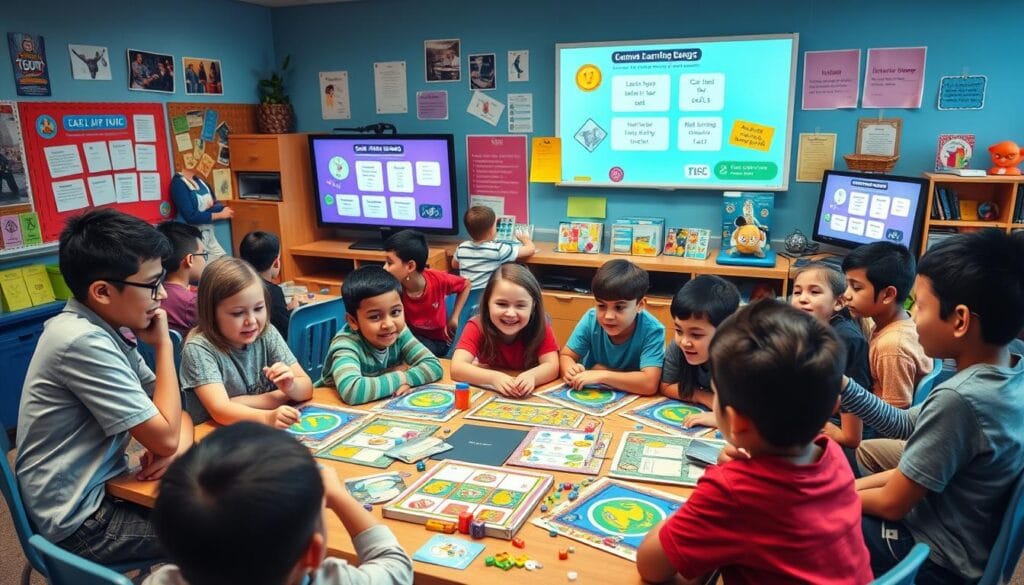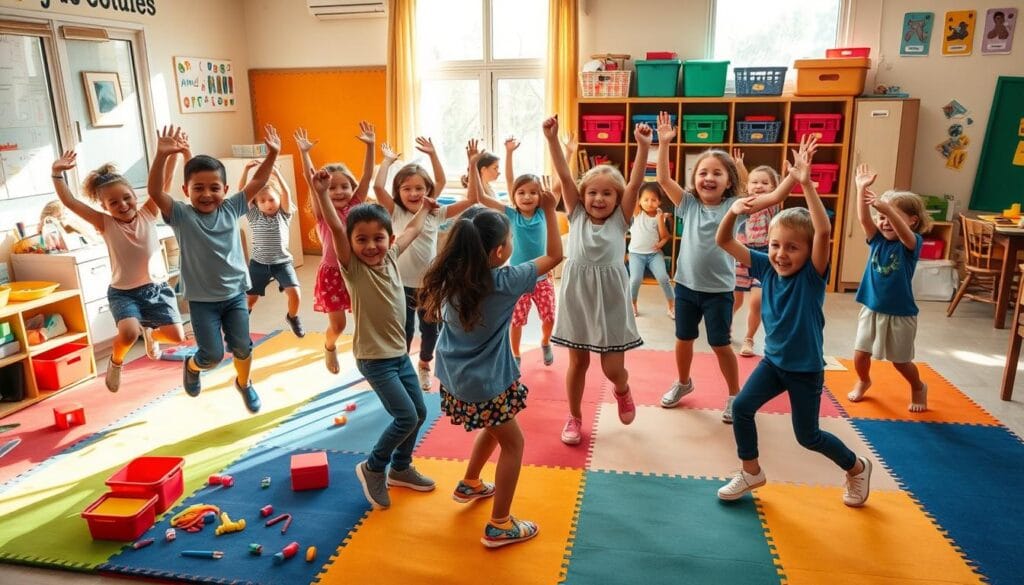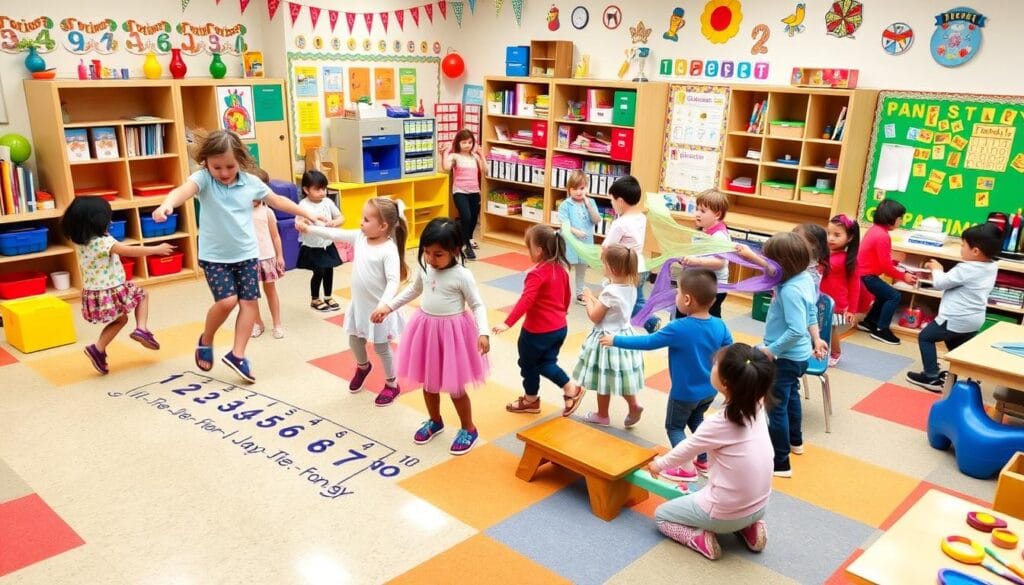How to Teach in a Creative and Fun Learning Methods?
In today’s fast world, old teaching methods often miss the mark. But, by using creative and fun learning, you can change that. This article shows you new ways to make learning exciting and effective for everyone.
فهرس المقالة
Understanding the Principles of Creative Learning
Learning effectively starts with knowing the basics of creative learning. By exploring the science of learning, you can break down old learning barriers. This leads to a more engaging learning space.
The Science Behind Effective Learning
Studies reveal that our brains love new things, interaction, and using more than one sense. Good learning uses these brain-friendly elements to spark curiosity and help us remember better. Creative learning mixes fun activities, teamwork, and feedback to make learning better.
Breaking Traditional Learning Barriers
- Challenging the one-size-fits-all model of education
- Fostering a growth mindset and encouraging risk-taking
- Integrating real-world applications and interdisciplinary connections
- Empowering learners to take an active role in their own effective learning
Creating an Engaging Learning Environment
To make creative learning work, we need a space that sparks curiosity and teamwork. By adding multimedia, hands-on projects, and chances for self-expression, teachers can create a lively learning space. This space supports students’ natural curiosity and different learning ways.
“The function of education is to teach one to think intensively and to think critically. Intelligence plus character – that is the goal of true education.” – Martin Luther King Jr.
Fun Learning Methods That Transform Education
Innovative teaching methods are changing education, making learning fun and engaging. These fun learning methods grab students’ attention and help them reach their full potential. They also spark a lasting interest in what they’re learning.
Interactive learning is a key approach in classrooms today. It includes hands-on activities, role-playing, and problem-solving. This method boosts student participation and critical thinking, leading to better retention and a more enthusiastic learning experience.
Gamification in education is another effective method. It uses game elements like points and rewards to make learning a challenge. This approach not only makes learning fun but also helps students develop important skills like strategic thinking and teamwork.
Technology is also changing how students learn. Tools like virtual reality and learning apps make education more interactive and engaging. These digital tools are transforming the learning environment.
The fun learning methods that are changing education do more than entertain. They unlock students’ potential, creating a love for learning that goes beyond the classroom.
“Education is the most powerful weapon which you can use to change the world.” – Nelson Mandela
Implementing Gamification in Education
Gamification is changing education, making it more fun and rewarding. It adds game elements to learning, making it exciting for students. This approach helps students love learning more.
Digital Games and Learning Apps
Digital games and apps make learning interactive and fun. They have easy-to-use interfaces, challenges, and feedback for students. This encourages them to learn and explore new ideas.
From coding to virtual trips, gamification through digital tools sparks a love for learning.
Point Systems and Rewards
Point systems and rewards are key in gamification. They set goals and offer incentives for students to do well. This includes virtual badges and leaderboards, making learning rewarding.
Students feel accomplished and want to keep learning with these systems.
Competitive Learning Activities
Gamification brings competition to the classroom. It includes team challenges and individual quests. This encourages teamwork, strategy, and personal growth.
It makes students want to do better, leading to better learning results.
By using gamification, teachers can make learning fun and engaging. This approach helps students love learning and do well in school. As gamification grows, so do the chances to improve education and help students reach their full potential.

| Gamification Technique | Benefits | Examples |
|---|---|---|
| Digital Games and Learning Apps | Increased engagement, interactive learning, personalized feedback | Coding simulations, virtual field trips, educational game-based platforms |
| Point Systems and Rewards | Motivation, sense of achievement, continued learning | Virtual badges, leaderboards, tangible rewards |
| Competitive Learning Activities | Collaboration, strategic thinking, personal growth | Team-based challenges, individual quests, learning competitions |
Storytelling as a Powerful Teaching Tool
Storytelling is now a key part of education, making learning fun and effective. It helps teachers reach students’ full potential. This leads to better engagement, retention, and understanding of what they learn.
Using storytelling in teaching changes how we learn. It connects with our love for stories. This makes learning memorable and engaging for everyone, no matter their age or background.
Harnessing the Magic of Narrative Learning
Adding stories to education greatly improves student results. Studies show that narrative learning boosts retention, problem-solving, and emotional connection to what’s learned.
- Stories engage our senses, making hard ideas easier to grasp.
- Educational storytelling works in many subjects, from history to language arts.
- Stories in lessons make learning more fun and personal for students.
Using storytelling techniques in class opens up new ways of understanding. It encourages critical thinking and makes students more involved in their learning.
| Storytelling Technique | Educational Application |
|---|---|
| Narrative Structures | Improves understanding and remembering of history, science, or literature |
| Character Development | Helps see different views, builds empathy, and tackles complex issues |
| Imaginative Storytelling | Boosts creativity, problem-solving, and connects subjects |
By using storytelling, teachers can make learning exciting. This inspires students to explore and understand the world in new ways.
“Storytelling is the most powerful way to put ideas into the world today.” – Robert McKee
Interactive Exercises and Hands-on Activities

Interactive exercises and hands-on activities boost learning. They make learning fun and help students think better. Students get to understand concepts deeply.
Role-playing Scenarios
Role-playing lets students be different characters. They explore real-life situations. This way, they become more creative and empathetic.
By playing different roles, students see things from new angles. They get better at making decisions and talking to others.
Group Dynamics and Team Projects
Working in groups teaches teamwork and communication. Students share ideas and work together. They learn to solve problems as a team.
This approach prepares students for the real world. It shows them how to work well with others.
Problem-solving Challenges
Problem-solving exercises make students think deeply. They learn to analyze and find new solutions. These challenges are like real-life puzzles.
By solving these problems, students grow their critical thinking and creativity. They become more adaptable too.
| Interactive Learning Techniques | Key Benefits |
|---|---|
| Role-playing Scenarios | Develop empathy, creativity, and practical application of knowledge |
| Group Dynamics and Team Projects | Foster teamwork, communication, and conflict resolution skills |
| Problem-solving Challenges | Cultivate critical thinking, creativity, and adaptability |
Interactive exercises and hands-on activities make learning exciting. They help students grow and succeed in many ways.
Virtual Reality and Technology in Learning
In today’s education, virtual reality (VR) simulations and new tech are changing how we learn. Virtual reality simulations let teachers create engaging lessons that grab students’ attention. This makes learning fun and exciting.
Educational technology has brought big changes to classrooms. Tools like interactive 3D models and augmented reality make learning more fun. They help students understand better and make learning more interactive.
Teachers can now use the latest tech to make hard subjects easier to grasp. For example, VR can take students to places like historical sites or the ocean. This lets them explore and interact with learning in a new way.
“Virtual reality has the power to transform the way we learn, allowing students to dive into the heart of the subject matter and gain a deeper, more meaningful understanding.”
As education keeps changing, virtual reality simulations and new educational technology will be key. They will help create more engaging and fun learning experiences for students everywhere.
Project-Based Learning Strategies
Project-based learning is changing education. It makes students creative, think critically, and apply what they learn in real life. Students work on projects that challenge them, teach them practical skills, and help them understand their subjects better.
Real-world Applications
Project-based learning focuses on real-world uses. It sets up projects that reflect what students might face in their careers or daily life. This makes learning more relevant and prepares students for problem-solving and adapting.
Cross-disciplinary Projects
This method also brings together knowledge from different subjects. It combines science, technology, engineering, and the arts. Students get a broad view and learn from different angles. This prepares them for the complex world of work, where teamwork and flexibility are key.
Student-led Initiatives
At the core of project-based learning is giving students control over their learning. By letting them lead their projects, teachers encourage creativity and self-learning. This approach boosts engagement, motivation, and develops important skills like problem-solving and teamwork.
By using project-based learning, teachers create a lively and effective learning space. It prepares students for the real world through practical applications, diverse projects, and student-led efforts. Students gain valuable skills and a deep understanding of their subjects, setting them up for success in school and work.
| Benefit | Description |
|---|---|
| Real-world Applications | Connecting learning to practical, real-world scenarios and challenges |
| Cross-disciplinary Projects | Integrating knowledge and skills from various academic disciplines |
| Student-led Initiatives | Empowering students to take an active role in shaping their learning experiences |
Creating Engaging Educational Escape Rooms
Escape room challenges are a fun way to make learning exciting. They turn learning into a team effort. Students learn to think critically, communicate well, and work together.
To make a great educational escape room, plan carefully. First, decide what skills or concepts you want to teach. Then, add these to the room’s design. Use a story or theme that grabs students’ attention and makes them want to solve puzzles together.
- Develop a range of escape room challenges that address different learning styles and abilities.
- Incorporate educational puzzles that encourage collaborative problem-solving and critical thinking.
- Provide visual aids, tactile elements, and interactive components to engage multiple senses.
Creating a mix of learning and fun can spark a love for learning. The excitement of solving puzzles and escaping can make students eager to learn more. It’s a way to make learning fun and exciting.
“Escape rooms are a unique and engaging way to bring learning to life. They challenge students to think critically, communicate effectively, and work together to overcome obstacles.”
Setting up educational escape rooms needs careful planning. Make sure the puzzles are right for the students, the time limits are fair, and the space is good for teamwork. Check how well the escape room works and change it to make it better.
Escape room challenges can make learning fun and engaging. They offer a chance to change how we teach and help students grow. It’s a way to make learning exciting and full of possibilities.
Incorporating Movement and Kinesthetic Learning
Getting students to move and learn is a great way to make school better. Using kinesthetic activities and movement-based learning changes how students learn. It helps them remember and understand more.
Physical Activities in Learning
Making lessons active can improve focus and energy. Activities like role-playing and hands-on experiments get students moving. This active learning method makes learning stick through different senses.
Dance and Music Integration
Adding dance, music, and learning is a fun way to engage students. They can dance to show math patterns or act out history. Music and movement help with language and speech too.
Active Learning Exercises
- Gallery Walks: Students move around to look at displays and talk.
- Scavenger Hunts: Students search for and use information in hands-on tasks.
- Kinesthetic Concept Maps: Students make physical maps of ideas and connections through movement.
Using kinesthetic activities, movement-based learning, and active learning makes learning fun and engaging. It encourages students to explore and grow.

Using Memory Techniques and Mnemonic Devices
Unlock the power of your memory with mnemonic aids and memory techniques. These strategies can change how you learn and retention strategies. They help you remember complex info easily.
The “method of loci” is a famous mnemonic device. You imagine a place you know well. Then, you link important info to spots in that place. This makes remembering details easy.
- Acrostic mnemonics: Turn a list into a memorable phrase or sentence.
- Rhyming and rhythm: Use a catchy tune or rhyme to remember facts better.
- Storytelling: Make key concepts part of a story to remember them better.
- Chunking: Break down big data into smaller parts for easier recall.
Using these memory techniques can improve your learning. Try different methods to find what works best for you.
“The true sign of intelligence is not knowledge but imagination.” – Albert Einstein
With mnemonic aids and memory techniques, you can change how you learn and retention strategies. This unlocks new success in school and life.
Conclusion
In this article, we’ve shown how fun and creative learning can change education. By using effective learning methods, breaking down old ways, and adding fun like games and stories, we can make learning exciting. This approach creates a lively and engaging place for students to learn and grow.
If you teach or love to learn, these ideas are very helpful. By using fun learning methods, creative education, and engaging teaching strategies, you can help students understand more and love learning. This way, you help them reach their highest potential.
We suggest trying out these methods and making them fit your own teaching style. Always aim to make learning both fun and educational. This way, you’ll not only improve your students’ lives but also help education grow. You’ll help make learning a journey of discovery and inspiration for everyone.
FAQ
What are some fun learning methods that can transform traditional education?
Fun learning methods include gamification, storytelling, and interactive exercises. Hands-on activities, virtual reality, and project-based learning are also great. Educational escape rooms can make learning exciting. These methods boost engagement and retention.
How can educators incorporate gamification into their teaching approaches?
Educators can use digital games and apps to make learning fun. They can also create point systems and rewards. This makes learning more engaging and motivates students.
What are the benefits of using storytelling in education?
Storytelling makes learning fun and engaging. It helps students understand complex ideas better. It also improves retention of information.
How can interactive exercises and hands-on activities improve learning outcomes?
Interactive exercises and hands-on activities promote active learning. They encourage critical thinking and practical application. This helps students understand and retain information better.
What role does virtual reality play in transforming learning environments?
Virtual reality simulations create immersive learning experiences. They help students understand complex concepts better. VR makes learning more engaging and effective.
How can project-based learning strategies benefit students?
Project-based learning focuses on real-world applications. It develops critical thinking and problem-solving skills. It also makes learning more relevant and fun.
What are the advantages of incorporating movement and kinesthetic learning into the classroom?
Movement and kinesthetic learning enhance engagement and retention. They appeal to different learning styles. These methods improve focus and understanding.
How can memory techniques and mnemonic devices help students in their learning journey?
Memory techniques and mnemonic devices improve recall. They create associations and visual cues. These strategies help students master complex concepts and retain knowledge better.






